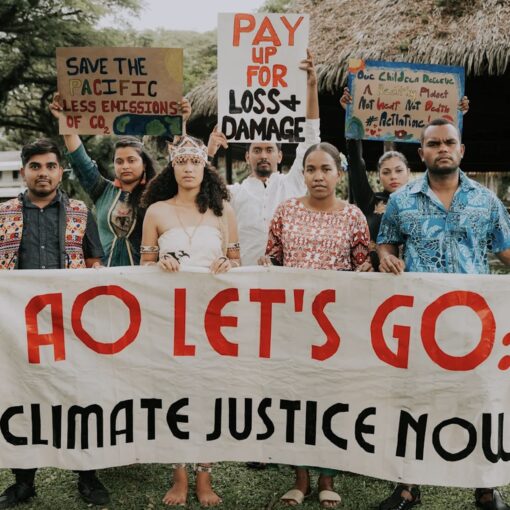The legal landscape for climate action is undergoing a paradigmatic shift. Whereas the primary focus was once on treaty negotiations and diplomacy, climate advocates are now increasingly turning to the courts. Yet as more rulings are handed down in favor of plaintiffs, important questions arise. Are these decisions driving meaningful change in States’ climate change policies? Are they catalyzing systemic reform, or are they merely symbolic victories?
To answer these questions, we must move beyond a narrow conception of success defined solely by legal outcomes, such as victory or defeat. In fact, the true power of climate litigation often lies in its ripple effects: the shifts it provokes in public discourse, the pressure it places on political systems, and the momentum it builds for civic activism. The European Court of Human Rights’ (ECtHR) groundbreaking judgment in Verein KlimaSeniorinnen and others v Switzerland (the KlimaSeniorinnen case) against Switzerland offers a compelling illustration. While the judgment marked a legal milestone in holding Swiss governments accountable for climate inaction, its real significance lies in the political debates it ignited, the resistance it encountered, and the civil society response it provoked. This post unpacks why KlimaSeniorinnen exemplifies a broader, multidimensional understanding of what success in climate litigation truly means.
Defining Success: Beyond Win or Loss
Legal outcomes in climate litigation often culminate in declaratory or injunctive relief. While these remedies are necessary, they are insufficient when used as sole metrics of success. Some of the most influential climate cases, such as Urgenda in the Netherlands or Germany’s Neubauer decision, have triggered legislative amendments and reaffirmed intergenerational justice.
In Urgenda, the Dutch Supreme Court imposed a minimum emissions reduction target, grounding its decision in Articles 2 and 8 European Convention on Human Rights (ECHR). That ruling brought significant legislative and policy shifts in the Netherlands, including the immediate closure of one coal-fired power station, a pledge to scale down others by 75%, and the adoption of a €3 billion emissions reduction package largely based on Urgenda’s ‘54 Climate Solutions Plan’.
Similarly, the Neubauer judgment also represented a major milestone in climate litigation and led to legislative amendments in Germany. In that case, the Federal Constitutional Court held that provisions of the Federal Climate Change Act were unconstitutional for placing disproportionate emissions reduction burdens on future generations, thereby violating fundamental rights under the German Basic Law. The ruling prompted the German government to revise the Act, setting more ambitious targets for emissions reductions by 2030. However, its application in judicial practice has not been consistently effective. While the decision has formed the basis for legal actions challenging specific infrastructure and development projects, the outcomes of such claims have been limited, and not all project-related lawsuits have been successful (e.g., BVerwG 9 A 7.21, BVerwG 7 A 9.22).
Other cases reveal the barriers of non-justiciability, where courts decline to adjudicate climate claims based on the political question doctrine or insufficient procedural standing. A recent Swedish Supreme Court decision—in Anton Foley and others v Sweden—exemplifies this restraint, revealing the judiciary’s reluctance to overstep into what are seen as political domains. Thus, litigation success must be conceptualized through a multi-dimensional lens: as a legal, political, and societal phenomenon. Nowhere is this more apparent than in the KlimaSeniorinnen case against Switzerland.
The ECtHR Judgment in KlimaSeniorinnen v Switzerland
In the KlimaSeniorinnen case, the ECtHR delivered a landmark judgment recognizing that Switzerland had breached its positive obligations under Article 8 ECHR by failing to adopt effective mitigation measures against climate change. Furthermore, the ECtHR also found a violation of Article 6(1) ECHR, citing the lack of effective access for the applicant association to challenge the implementation of national measures aimed at addressing the effects of climate change.
This judgment is legally significant for several reasons. First, it expands the interpretation of Article 8 to encompass systemic climate inaction as a justiciable rights violation of individual rights. Second, it affirms the standing of associations in climate claims—a significant development in overcoming procedural hurdles that often limit access to justice in traditional environmental cases.
Importantly, the ECtHR issued a declaratory judgment rather than a specific remedial order under Article 46 ECHR. Although it refrained from prescribing precise legislative content, it explicitly stated that post-2024 climate legislation in Switzerland must include quantified greenhouse gas reduction targets, such as a national carbon budget or a functionally equivalent mechanism (para. 570). This reflects a shift toward enforceable environmental governance to align domestic obligations with international climate objectives under the Paris Agreement.
Yet the judgment also reveals the cautious approach of international courts. The ECtHR dismissed the victim status of individual applicants and declined to engage with broader claims around intergenerational equity or more intrusive forms of relief, such as structural injunctions. Instead it anchored its reasoning in procedural deficiencies and emphasized the necessity of legal certainty, thereby balancing legal innovation with institutional prudence.
Initial Resistance from Swiss Government and Politicians
The ECtHR’s judgment in the KlimaSeniorinnen case was met with significant push-back from the Swiss government. Members of the Swiss People’s Party accused the Court of judicial activism and interference with Swiss sovereignty, arguing that Switzerland’s democratic model—especially its reliance on referenda—should shield national policies from external judicial mandates. Their rhetoric framed the ECtHR judgment as an overreach that illegitimately imposed foreign values onto Swiss self-governance.
This hostile reaction was reinforced by institutional actors who framed the judgment as overreach by the ECtHR. In fact, both chambers of the Swiss parliament adopted recommendations urging the Federal Council not to implement the judgment. It was argued that there was no reason to take further action because Switzerland was already doing enough to address climate change.
Amid this tense political climate, the Federal Council adopted a cautious stance on the issue. It released a statement in August 2024 acknowledging the judgment, reaffirming Switzerland’s membership in the Council of Europe, and emphasizing the importance of the ECHR system. However, it stopped short of committing to any substantive reforms. Instead, the Council argued that Switzerland’s existing climate policy—particularly the revised CO₂ Act for 2025–2030—already addresses the concerns raised by the Court, suggesting that no major legislative changes are necessary.
Civil Society, Media and Public Pushback
Despite this wave of political and institutional resistance, different civil society organizations (see e.g., here, here and here) rapidly mobilized to counter the dominant narrative advanced by government officials—that Switzerland is already doing enough on climate change and that the KlimaSeniorinnen judgment constitutes unwarranted external interference. They reacted by emphasizing that the KlimaSeniorinnen judgment was not an external interference, but rather a binding affirmation of fundamental human rights in the context of the climate crisis.
Swiss and international media outlets played a major role in amplifying these messages. Leading newspapers, radio, and television channels provided platforms for legal scholars, environmental activists, and political commentators to critique the government and Parliament’s resistance. It was argued that Switzerland’s credibility as a defender of human rights globally was at risk if it openly defied a binding ECtHR judgment. The media narrative increasingly framed respect for the judgment as a test of Switzerland’s commitment to the rule of law.
This sustained civil society mobilization and media scrutiny gradually shifted the political atmosphere. By the time the Federal Council prepared its formal submission to the Committee of Ministers in October 2024, the tone of the government’s Action Report was notably diplomatic. The Committee of Ministers—responsible for supervising the execution of ECtHR judgments—uses a mix of soft and hard tools to ensure compliance, including dialogue, political pressure, and, in rare cases, formal resolutions or infringement proceedings. The government argued that alternative instruments (e.g., sectoral emissions caps and international offsets) provided sufficient flexibility under the doctrine of the margin of appreciation so that there was no need to adopt a quantified national carbon budget. This stance triggered further reaction from civil society groups. Several NGOs and civil society groups filed submissions (see here and here) under Rule 9.2 of the Committee’s monitoring mechanism. They argued that failure to adopt a quantifiable emissions framework violated the ECtHR’s reasoning in paragraph 570 of the judgment.
In March 2025, the Committee of Ministers issued a decision concluding that Switzerland had not yet complied with the ECtHR’s judgment in KlimaSeniorinnen case. It emphasized the necessity for Switzerland to establish a quantified framework for greenhouse gas emissions reductions, such as through a carbon budget, to align with the ECHR’s requirements. This development is significant as it illustrates how declaratory relief, when coupled with strong compliance oversight and engagement of civil society groups can evolve into effective enforcement mechanisms. Nonetheless, the Committee did not address whether the judgment requires Switzerland to adopt a carbon budget in line with a specific ‘fair share’ or ‘equal per capita emissions’ approach. The extent to which the ECtHR’s judgment mandates such substantive recalibrations remains subject to debate (see Rule 9.2 submissions by NGOs and Swiss Action Report). While acknowledging the positive steps Switzerland has taken, the Committee maintained a diplomatic tone—an aspect worth noting.
Conclusion
The KlimaSeniorinnen case teaches us that success in climate litigation cannot be measured solely by court orders or compliance checklists. True success lies in the broader ripple effects such litigation creates, including the public debates it sparks, the political pressure it generates, and the legal frameworks it reshapes.
While Switzerland’s initial resistance to the ECtHR judgment exposes the limitations of judicial influence over climate policy, the ongoing compliance process and civil society mobilization underscore the indirect strength of rights-based climate litigation. The courtroom may initiate change, but it is through political negotiation, public scrutiny, civic engagement, and transnational solidarity that such change becomes impactful and durable. Ultimately, KlimaSeniorinnen is a case with not only legal significance, but also social and political importance. It shows that when litigation is rooted in a broader socio-political movement, it holds the potential to transform legal victories into systemic change—though such transformation depends on sustained pressure, oversight, and political will, which remain to be seen in the KlimaSeniorinnen case and similar lawsuits in the future.

Ayyoub Jamali
Ayyoub (Hazhar) Jamali is a postdoctoral researcher at the Faculty of Law, University of Zurich. He conducts research on the theme of remedies in climate change litigation.




